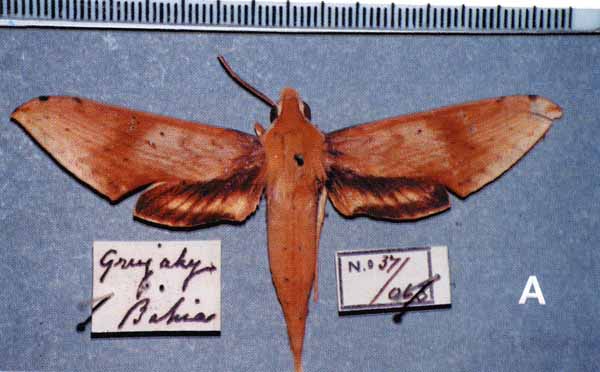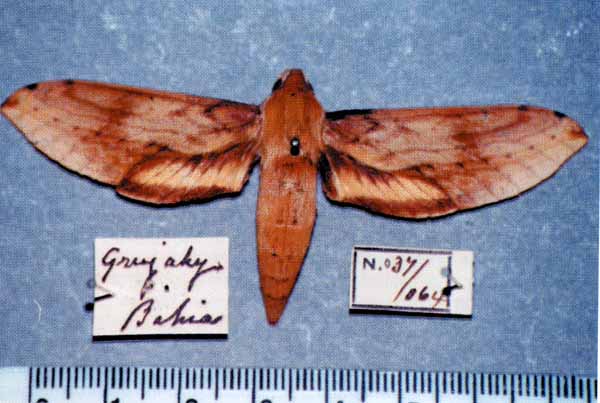Xylophanes pearsoni
Xylophanes pearsoni
Soares and da Silva Motta, 2002

Xylophanes pearsoni male, courtesy of Catarina da Silva Motta.
This site has been created by
Bill Oehlke at oehlkew@islandtelecom.com
Comments, suggestions and/or additional information are welcomed by Bill.
TAXONOMY:
Family: Sphingidae, Latreille, 1802
Subfamily: Macroglossinae, Harris, 1839
Tribe: Macroglossini, Harris, 1839
Genus: Xylophanes Hubner [1819] ...........
Species: pearsoni Soares and Motta, 2002
|
MIDI MUSIC
.....It's a Wonderful World.....
copyright C. Odenkirk
ON.OFF
<bgsound src="world.mid" LOOP=FOREVER>
|
DISTRIBUTION:
Xylophanes pearsoni (forewing length: males 35mm; females 36mm)
fies in Bahia, Brazil (specimen type locality) and throughout eastern Brazil.
"Extremely similar to Xylophanes libya.
Forewing upperside as Xylophanes libya but pattern much more uniform, postmedian lines weaker, fourth postmedian line indicated by a very fine line
joining a row of vein dots; black subapical spot conspicuous.
As Xylophanes libya but first postmedian line continuous.
Hindwing upperside as Xylophanes libya but median band barely extending apically beyond M1 and partially divided into separate spots by the black scaling
extending distad along the veins, especially M3 and CuA1 (thus resembling a more extreme version of the pattern seen in Xylophanes loelia).
"Female: Similar to the male but with broader and more rounded forewings.
Forewing upperside similar to that of the male but pattern more contrasting, subbasal and postmedian lines more conspicuous, especially the first postmedian line
apical of M3 and the third postmedian line along its entire, rather sinuate, length.
Hindwing upperside similar to that of the male but the median band broader and not interrupted by the black scaling extending distad along the veins."
FLIGHT TIMES:
Xylophanes pearsoni adults fly????
ECLOSION:
Pupae probably wiggle to surface from subterranean chambers just prior to eclosion.

Xylophanes pearsoni female, courtesy of Catarina da Silva
Motta.
SCENTING AND MATING:Females call in the males with a pheromone released from a gland at the tip of the
abdomen.
EGGS, LARVAE, PUPAE:
Larvae probably feed on
members of the Rubiaceae or Malvaceae families.
Moths emerge approximately one-two months after larvae pupate.
Use your browser "Back" button to return to the previous page.
Goto Main Sphingidae Index
Goto Macroglossini Tribe
Goto Central American Indices
Goto Carribean Islands
Goto South American Indices
Goto U.S.A. tables

